A Review of the As-Built SLM Ti-6Al-4V Mechanical Properties towards Achieving Fatigue Resistant Designs
Abstract
:1. Introduction
2. Microstructure of Ti-6Al-4V Manufactured by Selective Laser Melting (SLM)
2.1. α Microstructure
2.2. (α + β) Microstructure
2.3. Microstructures Examined
- Bimodal (duplex) microstructure, composed of lamellar (α + β) colonies and interconnected equiaxed primary α.
- Lamellar (α + β) microstructure, composed of α lamellae within β grains.
- Equiaxed (globular) microstructure, consisting of equiaxed primary α with β along the grain boundaries.
- Acicular α’ martensite.
3. Build Defects and Residual Stresses
3.1. Build Defects and the Influence of Gas Flow
3.2. Residual Stresses
4. Influence of the Microstructure, Residual Stress and Porosity on Mechanical Properties
4.1. Laser Scanning Strategy, Build Orientation and Type Test Coupons
4.2. Monotonic Properties
4.2.1. Behaviour under Tension
4.2.2. Behaviour under Torsion
4.2.3. Micro-Mechanism Contribution
4.3. Monotonic Properties
Micro-Mechanism Contribution
4.4. High Cycle Fatigue Behaviour
4.4.1. Axial Fatigue Loading
4.4.2. Torsional Fatigue Loading
4.4.3. Micro-Mechanism Contribution
- The Lamellar microstructure, where it was suggested that an α lamellae width of less than 1 μm could improve HCF resistance;
- The Equiaxed microstructure, with the greatest resistance occurring when the primary α size was less than 6 μm.
4.5. Low Cycle Fatigue Behaviour
4.5.1. Axial Fatigue Loading
4.5.2. Torsion Fatigue Loading
4.5.3. Micro-Mechanism Contribution
4.6. Multiaxial Fatigue Behaviour
Micro-Mechanism Contribution
5. Conclusions
- SLM processing parameters;
- Microstructural information, including phases present and size;
- Porosity;
- Location on the build platform;
- Whether it was a single or multiple build;
- Scanning strategy.
Acknowledgments
Author Contributions
Conflicts of Interest
References
- Murr, L.E.; Quinones, S.A.; Gaytan, S.M.; Lopez, M.I.; Rodela, A.; Martinez, E.Y.; Hernandez, D.H.; Martinez, E.; Medina, F.; Wicker, R.B. Microstructure and mechanical behavior of Ti-6Al-4V produced by rapid-layer manufacturing, for biomedical applications. J. Mech. Behav. Biomed. Mater. 2009, 2, 20–32. [Google Scholar] [CrossRef] [PubMed]
- Kürnsteiner, P.; Wilms, M.B.; Weisheit, A.; Barriobero-Vila, P.; Jägle, E.A.; Raabe, D. Massive nanoprecipitation in an Fe-19Ni-xAl maraging steel triggered by the intrinsic heat treatment during laser metal deposition. Acta Mater. 2017, 129, 52–60. [Google Scholar] [CrossRef]
- Morton, P.A.; Mireles, J.; Mendoza, H.; Cordero, P.M.; Benedict, M.; Wicker, R.B. Enhancement of Low-Cycle Fatigue Performance From Tailored Microstructures Enabled by Electron Beam Melting Additive Manufacturing Technology. J. Mech. Des. 2015, 137, 111412–111414. [Google Scholar] [CrossRef]
- Vrancken, B.; Thijs, L.; Kruth, J.P.; Van Humbeeck, J. Heat treatment of Ti6Al4V produced by Selective Laser Melting: Microstructure and mechanical properties. J. Alloys Compd. 2012, 541, 177–185. [Google Scholar] [CrossRef]
- Chen, L.Y.; Huang, J.C.; Lin, C.H.; Pan, C.T.; Chen, S.Y.; Yang, T.L.; Lin, D.Y.; Lin, H.K.; Jang, J.S.C. Anisotropic response of Ti-6Al-4V alloy fabricated by 3D printing selective laser melting. Mater. Sci. Eng. A 2017, 682, 389–395. [Google Scholar] [CrossRef]
- Qiu, C.; Adkins, N.J.E.; Attallah, M.M. Microstructure and tensile properties of selectively laser-melted and of HIPed laser-melted Ti-6Al-4V. Mater. Sci. Eng. A 2013, 578, 230–239. [Google Scholar] [CrossRef]
- Shi, X.; Ma, S.; Liu, C.; Wu, Q.; Lu, J.; Liu, Y.; Shi, W. Selective laser melting-wire arc additive manufacturing hybrid fabrication of Ti-6Al-4V alloy: Microstructure and mechanical properties. Mater. Sci. Eng. A 2017, 684, 196–204. [Google Scholar] [CrossRef]
- Simonelli, M.; Tse, Y.Y.; Tuck, C. Effect of the build orientation on the mechanical properties and fracture modes of SLM Ti-6Al-4V. Mater. Sci. Eng. A 2014, 616, 1–11. [Google Scholar] [CrossRef]
- Xu, W.; Lui, E.W.; Pateras, A.; Qian, M.; Brandt, M. In situ tailoring microstructure in additively manufactured Ti-6Al-4V for superior mechanical performance. Acta Mater. 2017, 125, 390–400. [Google Scholar] [CrossRef]
- Ahmed, T.; Rack, H.J. Phase transformations during cooling in α + β titanium alloys. Mater. Sci. Eng. A 1998, 243, 206–211. [Google Scholar] [CrossRef]
- Al-Bermani, S.S.; Blackmore, M.L.; Zhang, W.; Todd, I. The origin of microstructural diversity, texture, and mechanical properties in electron beam melted Ti-6Al-4V. Metall. Mater. Trans. A Phys. Metall. Mater. Sci. 2010, 41, 3422–3434. [Google Scholar] [CrossRef]
- Yang, J.; Yu, H.; Yin, J.; Gao, M.; Wang, Z.; Zeng, X. Formation and control of martensite in Ti-6Al-4V alloy produced by selective laser melting. Mater. Des. 2016, 108, 308–318. [Google Scholar] [CrossRef]
- Yang, J.; Han, J.; Yu, H.; Yin, J.; Gao, M.; Wang, Z.; Zeng, X. Role of molten pool mode on formability, microstructure and mechanical properties of selective laser melted Ti-6Al-4V alloy. Mater. Des. 2016, 110, 558–570. [Google Scholar] [CrossRef]
- Lütjering, G. Influence of processing on microstructure and mechanical properties of (α + β) titanium alloys. Mater. Sci. Eng. A 1998, 243, 32–45. [Google Scholar] [CrossRef]
- Xu, W.; Brandt, M.; Sun, S.; Elambasseril, J.; Liu, Q.; Latham, K.; Xia, K.; Qian, M. Additive manufacturing of strong and ductile Ti-6Al-4V by selective laser melting via in situ martensite decomposition. Acta Mater. 2015, 85, 74–84. [Google Scholar] [CrossRef]
- Xu, W.; Sun, S.; Elambasseril, J.; Liu, Q.; Brandt, M.; Qian, M. Ti-6Al-4V Additively Manufactured by Selective Laser Melting with Superior Mechanical Properties. JOM 2015, 67, 668–673. [Google Scholar] [CrossRef]
- Simonelli, M.; Tse, Y.Y.; Tuck, C. The formation of α + β microstructure in as-fabricated selective laser melting of Ti-6Al-4V. J. Mater. Res. 2014, 29, 2028–2035. [Google Scholar] [CrossRef]
- Ali, H.; Ma, L.; Ghadbeigi, H.; Mumtaz, K. In situ residual stress reduction, martensitic decomposition and mechanical properties enhancement through high temperature powder bed pre-heating of Selective Laser Melted Ti6Al4V. Mater. Sci. Eng. A 2017, 695, 211–220. [Google Scholar] [CrossRef]
- Ter Haar, G.M.; Becker, T.H.; Blaine, D.C. Influence of heat treatments on the microstructure and tensile behaviour of selective laser melting-produced TI-6AL-4V parts. S. Afr. J. Ind. Eng. 2016, 27, 174–183. [Google Scholar] [CrossRef]
- Vilaro, T.; Colin, C.; Bartout, J.D. As-fabricated and heat-treated microstructures of the Ti-6Al-4V alloy processed by selective laser melting. Metall. Mater. Trans. A Phys. Metall. Mater. Sci. 2011, 42, 3190–3199. [Google Scholar] [CrossRef]
- Barriobero-Vila, P.; Gussone, J.; Haubrich, J.; Sandlöbes, S.; Da Silva, J.C.; Cloetens, P.; Schell, N.; Requena, G. Inducing stable α + β microstructures during selective laser melting of Ti-6Al-4V using intensified intrinsic heat treatments. Materials 2017, 10, 268. [Google Scholar] [CrossRef] [PubMed]
- Kasperovich, G.; Haubrich, J.; Gussone, J.; Requena, G. Correlation between porosity and processing parameters in TiAl6V4 produced by selective laser melting. Mater. Des. 2016, 105, 160–170. [Google Scholar] [CrossRef]
- Grasso, M.; Colosimo, B.M. Process defects and in situ monitoring methods in metal powder bed fusion: A review. Meas. Sci. Technol. 2017, 28, 044005. [Google Scholar] [CrossRef]
- Gong, H.; Rafi, K.; Karthik, N.; Starr, T.; Stucker, B. Defect Morphology in Ti-6Al-4V Parts Fabricated by Selective Laser Melting and Electron Beam Melting. In Proceedings of the 24th Annual International Solid Freeform Fabrication Symposium—An Additive Manufacturing Conference, Austin, TX, USA, 12–14 August 2013; pp. 12–14. [Google Scholar]
- Panwisawas, C.; Qiu, C.L.; Sovani, Y.; Brooks, J.W.; Attallah, M.M.; Basoalto, H.C. On the role of thermal fluid dynamics into the evolution of porosity during selective laser melting. Scr. Mater. 2015, 105, 14–17. [Google Scholar] [CrossRef]
- Kasperovich, G.; Hausmann, J. Improvement of fatigue resistance and ductility of TiAl6V4 processed by selective laser melting. J. Mater. Process. Technol. 2015, 220, 202–214. [Google Scholar] [CrossRef]
- Kong, C.-J.; Tuck, C.J.; Ashcroft, I.A.; Wildman, R.D.; Hague, R. High density Ti6Al4V via SLM processing: Microstructure and mechanical properties. In Proceedings of the 22nd Annual International Solid Freeform Fabrication: An Additive Manufacturing Conference, Austin, TX, USA, 8–10 August 2011; University of Texas: Austin, TX, USA, 2011; pp. 475–483. [Google Scholar]
- Ferrar, B.; Mullen, L.; Jones, E.; Stamp, R.; Sutcliffe, C.J. Gas flow effects on selective laser melting (SLM) manufacturing performance. J. Mater. Process. Technol. 2012, 212, 355–364. [Google Scholar] [CrossRef]
- Ladewig, A.; Schlick, G.; Fisser, M.; Schulze, V.; Glatzel, U. Influence of the shielding gas flow on the removal of process by-products in the selective laser melting process. Addit. Manuf. 2016, 10, 1–9. [Google Scholar] [CrossRef]
- Mercelis, P.; Kruth, J.P. Residual stresses in selective laser sintering and selective laser melting. Rapid Prototyp. J. 2006, 12, 254–265. [Google Scholar] [CrossRef]
- Knowles, C.R.; Becker, T.H.; Tait, R.B. Residual stress measurements and structural integrity implications for selective laser melted Ti-6Al-4V. S. Afr. J. Ind. Eng. 2012, 23, 119–129. [Google Scholar] [CrossRef]
- Leuders, S.; Thöne, M.; Riemer, A.; Niendorf, T.; Tröster, T.; Richard, H.A.; Maier, H.J. On the mechanical behaviour of titanium alloy TiAl6V4 manufactured by selective laser melting: Fatigue resistance and crack growth performance. Int. J. Fatigue 2013, 48, 300–307. [Google Scholar] [CrossRef]
- Nickel, A.H.; Barnett, D.M.; Prinz, F.B. Thermal stresses and deposition patterns in layered manufacturing. Mater. Sci. Eng. A 2001, 317, 59–64. [Google Scholar] [CrossRef]
- Shiomi, M.; Osakada, K.; Nakamura, K.; Yamashita, T.; Abe, F. Residual Stress within Metallic Model Made by Selective Laser Melting Process. CIRP Ann. 2004, 53, 195–198. [Google Scholar] [CrossRef]
- Klingbeil, N.W.; Beuth, J.L.; Chin, R.K.; Amon, C.H. Measurement and modeling of residual stress-induced warping in direct metal deposition processes. In Proceedings of the 1998 Solid Freeform Fabrication Symposium, Austin, TX, USA, 11–13 August 1998; pp. 367–374. [Google Scholar]
- Casavola, C.; Campanelli, S.L.; Pappalettere, C. Preliminary investigation on distribution of residual stress generated by the selective laser melting process. J. Strain Anal. Eng. Des. 2009, 44, 93–104. [Google Scholar] [CrossRef]
- Masoomi, M.; Thompson, S.M.; Shamsaei, N. Laser powder bed fusion of Ti-6Al-4V parts: Thermal modeling and mechanical implications. Int. J. Mach. Tools Manuf. 2017, 118–119, 73–90. [Google Scholar] [CrossRef]
- Lewandowski, J.J.; Seifi, M. Metal Additive Manufacturing: A Review of Mechanical Properties. Annu. Rev. Mater. Res. 2016, 46, 151–186. [Google Scholar] [CrossRef]
- Tong, J.; Bowen, C.R.; Persson, J.; Plummer, A. Mechanical properties of titanium-based Ti-6Al-4V alloys manufactured by powder bed additive manufacture. Mater. Sci. Technol. 2017, 33, 138–148. [Google Scholar] [CrossRef]
- Cain, V.; Thijs, L.; Van Humbeeck, J.; Van Hooreweder, B.; Knutsen, R. Crack propagation and fracture toughness of Ti6Al4V alloy produced by selective laser melting. Addit. Manuf. 2015, 5, 68–76. [Google Scholar] [CrossRef]
- Facchini, L.; Magalini, E.; Robotti, P.; Molinari, A.; Höges, S.; Wissenbach, K. Ductility of a Ti-6Al-4V alloy produced by selective laser melting of prealloyed powders. Rapid Prototyp. J. 2010, 16, 450–459. [Google Scholar] [CrossRef]
- Gong, H.; Rafi, K.; Gu, H.; Janaki Ram, G.D.; Starr, T.; Stucker, B. Influence of defects on mechanical properties of Ti-6Al-4 V components produced by selective laser melting and electron beam melting. Mater. Des. 2015, 86, 545–554. [Google Scholar] [CrossRef]
- Leuders, S.; Lieneke, T.; Lammers, S.; Tröster, T.; Niendorf, T. On the fatigue properties of metals manufactured by selective laser melting—The role of ductility. J. Mater. Res. 2014, 29, 1911–1919. [Google Scholar] [CrossRef]
- Mertens, A.; Reginster, S.; Paydas, H.; Contrepois, Q.; Dormal, T.; Lemaire, O.; Lecomte-Beckers, J. Mechanical properties of alloy Ti-6Al-4V and of stainless steel 316L processed by selective laser melting: Influence of out-of-equilibrium microstructures. Powder Metall. 2014, 57, 184–189. [Google Scholar] [CrossRef]
- Rafi, H.K.; Karthik, N.V.; Gong, H.; Starr, T.L.; Stucker, B.E. Microstructures and mechanical properties of Ti6Al4V parts fabricated by selective laser melting and electron beam melting. J. Mater. Eng. Perform. 2013, 22, 3872–3883. [Google Scholar] [CrossRef]
- Hollander, D.A.; von Walter, M.; Wirtz, T.; Sellei, R.; Schmidt-Rohlfing, B.; Paar, O.; Erli, H.-J. Structural, mechanical and in vitro characterization of individually structured Ti-6Al-4V produced by direct laser forming. Biomaterials 2006, 27, 955–963. [Google Scholar] [CrossRef] [PubMed]
- Fatemi, A.; Molaei, R.; Sharifimehr, S.; Shamsaei, N.; Phan, N. Torsional fatigue behavior of wrought and additive manufactured Ti-6Al-4V by powder bed fusion including surface finish effect. Int. J. Fatigue 2017, 99, 187–201. [Google Scholar] [CrossRef]
- Huang, Q.; Hu, N.; Yang, X.; Zhang, R.; Feng, Q. Microstructure and inclusion of Ti-6Al-4V fabricated by selective laser melting. Front. Mater. Sci. 2016, 10, 428–431. [Google Scholar] [CrossRef]
- Hennig, R.G.; Trinkle, D.R.; Bouchet, J.; Srinivasan, S.G.; Albers, R.C.; Wilkins, J.W. Impurities block the α to ω martensitic transformation in titanium. Nat. Mater. 2005, 4, 129–133. [Google Scholar] [CrossRef] [PubMed]
- Banerjee, D.; Williams, J.C. Perspectives on Titanium Science and Technology. Acta Mater. 2013, 61, 844–879. [Google Scholar] [CrossRef]
- Yang, J.; Yu, H.; Wang, Z.; Zeng, X. Effect of crystallographic orientation on mechanical anisotropy of selective laser melted Ti-6Al-4V alloy. Mater. Charact. 2017, 127, 137–145. [Google Scholar] [CrossRef]
- Van Hooreweder, B.; Moens, D.; Boonen, R.; Kruth, J.P.; Sas, P. Analysis of fracture toughness and crack propagation of Ti6Al4V produced by selective laser melting. Adv. Eng. Mater. 2012, 14, 92–97. [Google Scholar] [CrossRef]
- Edwards, P.; Ramulu, M. Effect of build direction on the fracture toughness and fatigue crack growth in selective laser melted Ti-6Al-4 V. Fatigue Fract. Eng. Mater. Struct. 2015, 38, 1228–1236. [Google Scholar] [CrossRef]
- Yadollahi, A.; Shamsaei, N. Additive manufacturing of fatigue resistant materials: Challenges and opportunities. Int. J. Fatigue 2017, 98, 14–31. [Google Scholar] [CrossRef]
- Galarraga, H.; Warren, R.J.; Lados, D.A.; Dehoff, R.R.; Kirka, M.M. Fatigue crack growth mechanisms at the microstructure scale in as-fabricated and heat treated Ti-6Al-4V ELI manufactured by electron beam melting (EBM). Eng. Fract. Mech. 2017, 176, 263–280. [Google Scholar] [CrossRef]
- Zhai, Y.; Lados, D.A.; Brown, E.J.; Vigilante, G.N. Fatigue crack growth behavior and microstructural mechanisms in Ti-6Al-4V manufactured by laser engineered net shaping. Int. J. Fatigue 2016, 93, 51–63. [Google Scholar] [CrossRef]
- Nalla, R.K.; Ritchie, R.O.; Boyce, B.L.; Campbell, J.P.; Peters, J.O. Influence of microstructure on high-cycle fatigue of Ti-6Al-4V: Bimodal vs. lamellar structures. Metall. Mater. Trans. A 2002, 33, 899–918. [Google Scholar] [CrossRef]
- Tao, J.; Hu, S.; Ji, L. Effect of micromorphology at the fatigue crack tip on the crack growth in electron beam welded Ti-6Al-4V joint. Mater. Charact. 2016, 120, 185–194. [Google Scholar] [CrossRef]
- Li, P.; Warner, D.H.; Fatemi, A.; Phan, N. Critical assessment of the fatigue performance of additively manufactured Ti-6Al-4V and perspective for future research. Int. J. Fatigue 2016, 85, 130–143. [Google Scholar] [CrossRef]
- Eric, W.; Claus, E.; Shafaqat, S.; Frank, W. High cycle fatigue (HCF) performance of Ti-6Al-4V alloy processed by selective laser melting. Adv. Mater. Res. 2013, 816–817, 134–139. [Google Scholar] [CrossRef]
- Rafi, H.K.; Starr, T.L.; Stucker, B.E. A comparison of the tensile, fatigue, and fracture behavior of Ti-6Al-4V and 15-5 PH stainless steel parts made by selective laser melting. Int. J. Adv. Manuf. Technol. 2013, 69, 1299–1309. [Google Scholar] [CrossRef]
- Edwards, P.; Ramulu, M. Fatigue performance evaluation of selective laser melted Ti-6Al-4V. Mater. Sci. Eng. A 2014, 598, 327–337. [Google Scholar] [CrossRef]
- Razavi, S.-M.-J.; Ferro, P.; Berto, F. Fatigue Assessment of Ti-6Al-4V Circular Notched Specimens Produced by Selective Laser Melting. Metals 2017, 7, 291. [Google Scholar] [CrossRef]
- Chan, K.S. Roles of microstructure in fatigue crack initiation. Int. J. Fatigue 2010, 32, 1428–1447. [Google Scholar] [CrossRef]
- Fan, J.; McDowell, D.L.; Horstemeyer, M.F.; Gall, K. Cyclic plasticity at pores and inclusions in cast Al-Si alloys. Eng. Fract. Mech. 2003, 70, 1281–1302. [Google Scholar] [CrossRef]
- Yadollahi, A.; Shamsaei, N.; Thompson, S.M.; Elwany, A.; Bian, L. Effects of building orientation and heat treatment on fatigue behavior of selective laser melted 17-4 PH stainless steel. Int. J. Fatigue 2017, 94, 218–235. [Google Scholar] [CrossRef]
- Mall, S.; Namjoshi, S.A.; Porter, W.J. Effects of microstructure on fretting fatigue crack initiation behavior of Ti-6Al-4V. Mater. Sci. Eng. A 2004, 383, 334–340. [Google Scholar] [CrossRef]
- Bantounas, I.; Lindley, T.C.; Rugg, D.; Dye, D. Effect of microtexture on fatigue cracking in Ti-6Al-4V. Acta Mater. 2007, 55, 5655–5665. [Google Scholar] [CrossRef]
- Wu, G.Q.; Shi, C.L.; Sha, W.; Sha, A.X.; Jiang, H.R. Effect of microstructure on the fatigue properties of Ti-6Al-4V titanium alloys. Mater. Des. 2013, 46, 668–674. [Google Scholar] [CrossRef] [Green Version]
- Holmes, J.; Queeney, R.A. Fatigue crack initiation in a porous steel. Powder Metall. 1985, 28, 231–235. [Google Scholar] [CrossRef]
- Kourousis, K.I.; Agius, D.; Wang, C.; Subic, A. Constitutive modeling of additive manufactured Ti-6Al-4V cyclic elastoplastic behaviour. Tech. Mech. 2016, 36, 57–72. [Google Scholar] [CrossRef]
- Phaiboonworachat, A.; Kourousis, K.I. Cyclic elastoplastic behaviour, hardness and microstructural properties of Ti-6Al-4V manufactured through selective laser melting. Int. J. Mater. Eng. Innov. 2016, 7, 80–87. [Google Scholar] [CrossRef]
- Agius, D.; Kourousis, K.I.; Wallbrink, C.; Song, T. Cyclic plasticity and microstructure of as-built SLM Ti-6Al-4V: The effect of build orientation. Mater. Sci. Eng. A 2017, 701, 85–100. [Google Scholar] [CrossRef]
- Dafalias, Y.F.; Kourousis, K.I.; Saridis, G.J. Multiplicative AF kinematic hardening in plasticity. Int. J. Solids Struct. 2008, 45, 2861–2880. [Google Scholar] [CrossRef]
- Gribbin, S.; Bicknell, J.; Jorgensen, L.; Tsukrov, I.; Knezevic, M. Low cycle fatigue behavior of direct metal laser sintered Inconel alloy 718. Int. J. Fatigue 2016, 93, 156–167. [Google Scholar] [CrossRef]
- Fatemi, A.; Molaei, R.; Sharifimehr, S.; Phan, N.; Shamsaei, N. Multiaxial fatigue behavior of wrought and additive manufactured Ti-6Al-4V including surface finish effect. Int. J. Fatigue 2017, 100, 347–366. [Google Scholar] [CrossRef]
- Evans, W.J.; Jones, J.P.; Whittaker, M.T. Texture effects under tension and torsion loading conditions in titanium alloys. Int. J. Fatigue 2005, 27, 1244–1250. [Google Scholar] [CrossRef]
- Kailas, S.V.; Prasad, Y.V.R.K.; Biswas, S.K. Influence of initial texture on the microstructural instabilities during compression of commercial α-Titanium at 25 °C to 400 °C. Metall. Mater. Trans. A 1994, 25, 1425–1434. [Google Scholar] [CrossRef]
- Gil, F.J.; Manero, J.M.; Ginebra, M.P.; Planell, J.A. The effect of cooling rate on the cyclic deformation of β-annealed Ti-6Al-4V. Mater. Sci. Eng. A 2003, 349, 150–155. [Google Scholar] [CrossRef]
- Tan, C.; Li, X.; Sun, Q.; Xiao, L.; Zhao, Y.; Sun, J. Effect of α-phase morphology on low-cycle fatigue behavior of TC21 alloy. Int. J. Fatigue 2015, 75, 1–9. [Google Scholar] [CrossRef]
- Åkerfeldt, P.; Pederson, R.; Antti, M.-L. A fractographic study exploring the relationship between the low cycle fatigue and metallurgical properties of laser metal wire deposited Ti-6Al-4V. Int. J. Fatigue 2016, 87, 245–256. [Google Scholar] [CrossRef]
- Kumar, P.; Ravi Chandran, K.S.; Cao, F.; Koopman, M.; Fang, Z.Z. The Nature of Tensile Ductility as Controlled by Extreme-Sized Pores in Powder Metallurgy Ti-6Al-4V Alloy. Metall. Mater. Trans. A 2016, 47, 2150–2161. [Google Scholar] [CrossRef]
- Nakamura, H.; Takanashi, M.; Itoh, T.; Wu, M.; Shimizu, Y. Fatigue crack initiation and growth behavior of Ti-6Al-4V under non-proportional multiaxial loading. Int. J. Fatigue 2011, 33, 842–848. [Google Scholar] [CrossRef]
- Bannantine, J.A.; Socie, D.F. A multiaxial fatigue life estimation technique. In Advances in Fatigue Lifetime Predictive Techniques; ASTM STP 1122; Mitchell, M.R., Landgraf, R.W., Eds.; American Society for Testing and Materials: Philadelphia, PA, USA, 1992; pp. 249–275. [Google Scholar]
- Macha, E. Simulation investigations of the position of Fatigue Fracture Plane in materials with biaxial loads. Materialwissenschaft Werkstofftechnik 1989, 20, 132–136. [Google Scholar] [CrossRef]
- Wu, M.; Itoh, T.; Shimizu, Y.; Nakamura, H.; Takanashi, M. Low cycle fatigue life of Ti-6Al-4V alloy under non-proportional loading. Int. J. Fatigue 2012, 44, 14–20. [Google Scholar] [CrossRef]
- Morishita, T.; Itoh, T.; Sakane, M.; Nakamura, H.; Takanashi, M. Multiaxial fatigue property of Ti-6Al-4V using hollow cylinder specimen under push-pull and cyclic inner pressure loading. Int. J. Fatigue 2016, 87, 370–380. [Google Scholar] [CrossRef]
- Berto, F.; Campagnolo, A.; Lazzarin, P. Fatigue strength of severely notched specimens made of Ti-6Al-4V under multiaxial loading. Fatigue Fract. Eng. Mater. Struct. 2015, 38, 503–517. [Google Scholar] [CrossRef]
- Marciniak, Z.; Rozumek, D.; Macha, E. Verification of fatigue critical plane position according to variance and damage accumulation methods under multiaxial loading. Int. J. Fatigue 2014, 58, 84–93. [Google Scholar] [CrossRef]
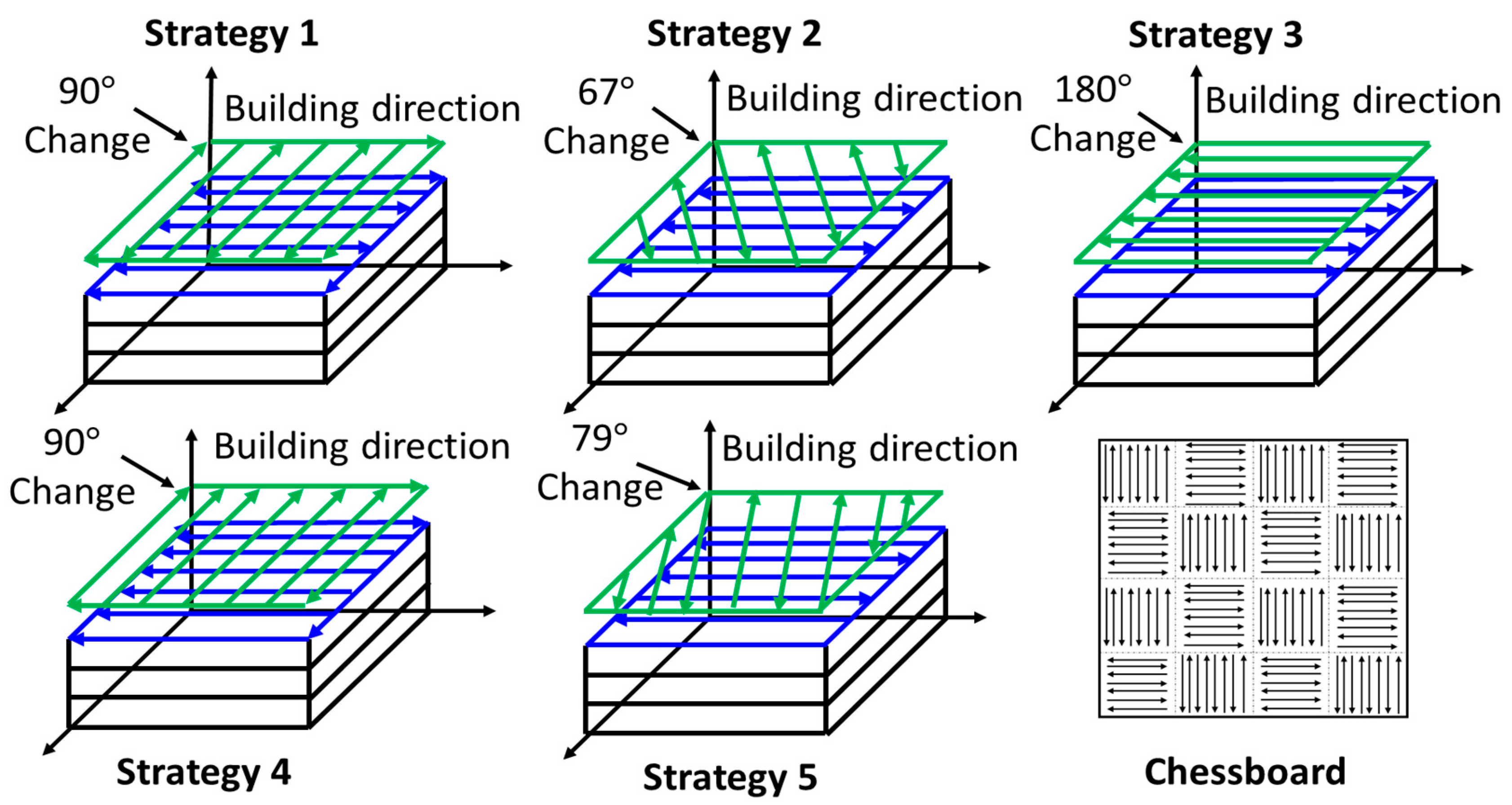


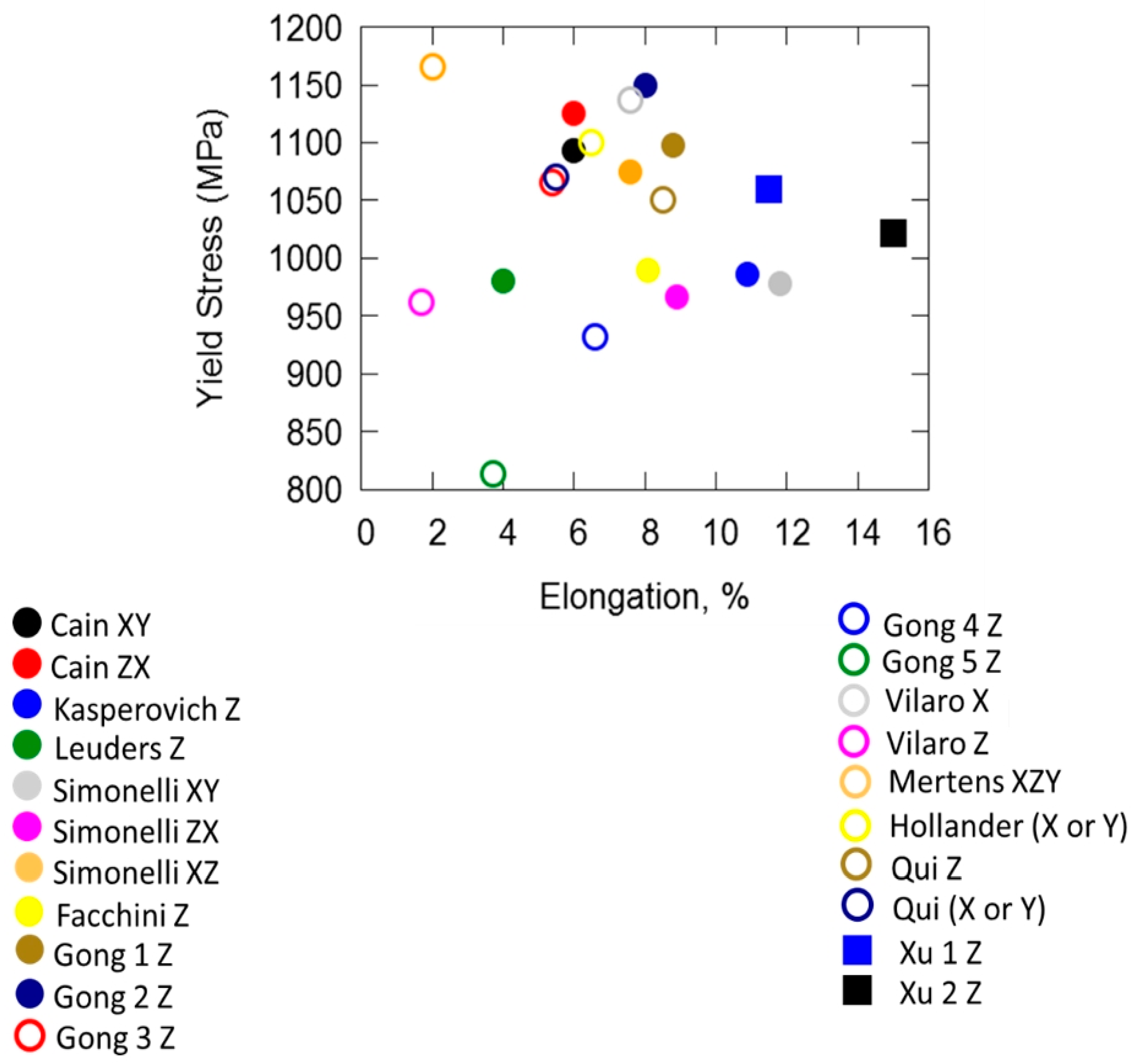
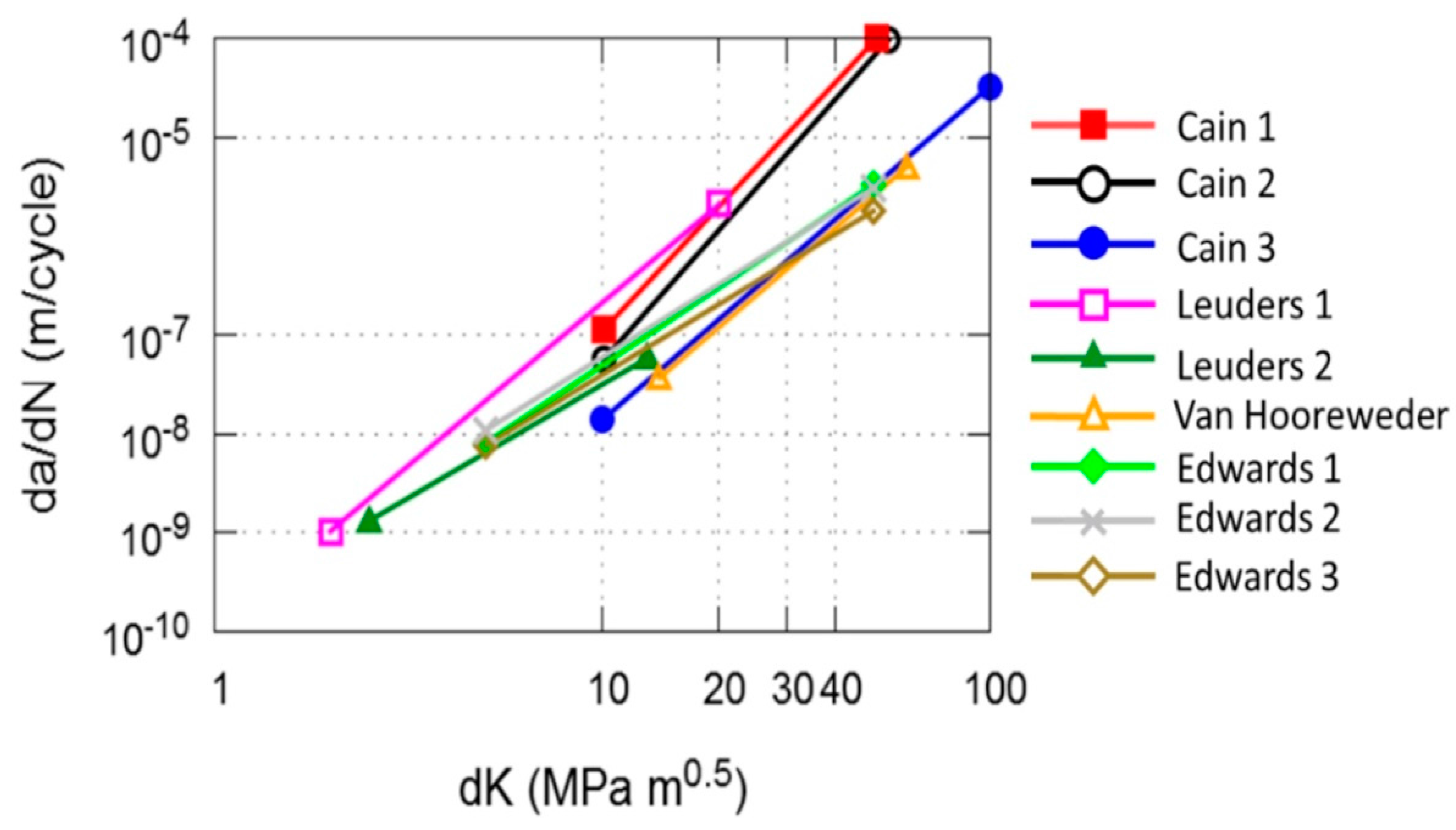
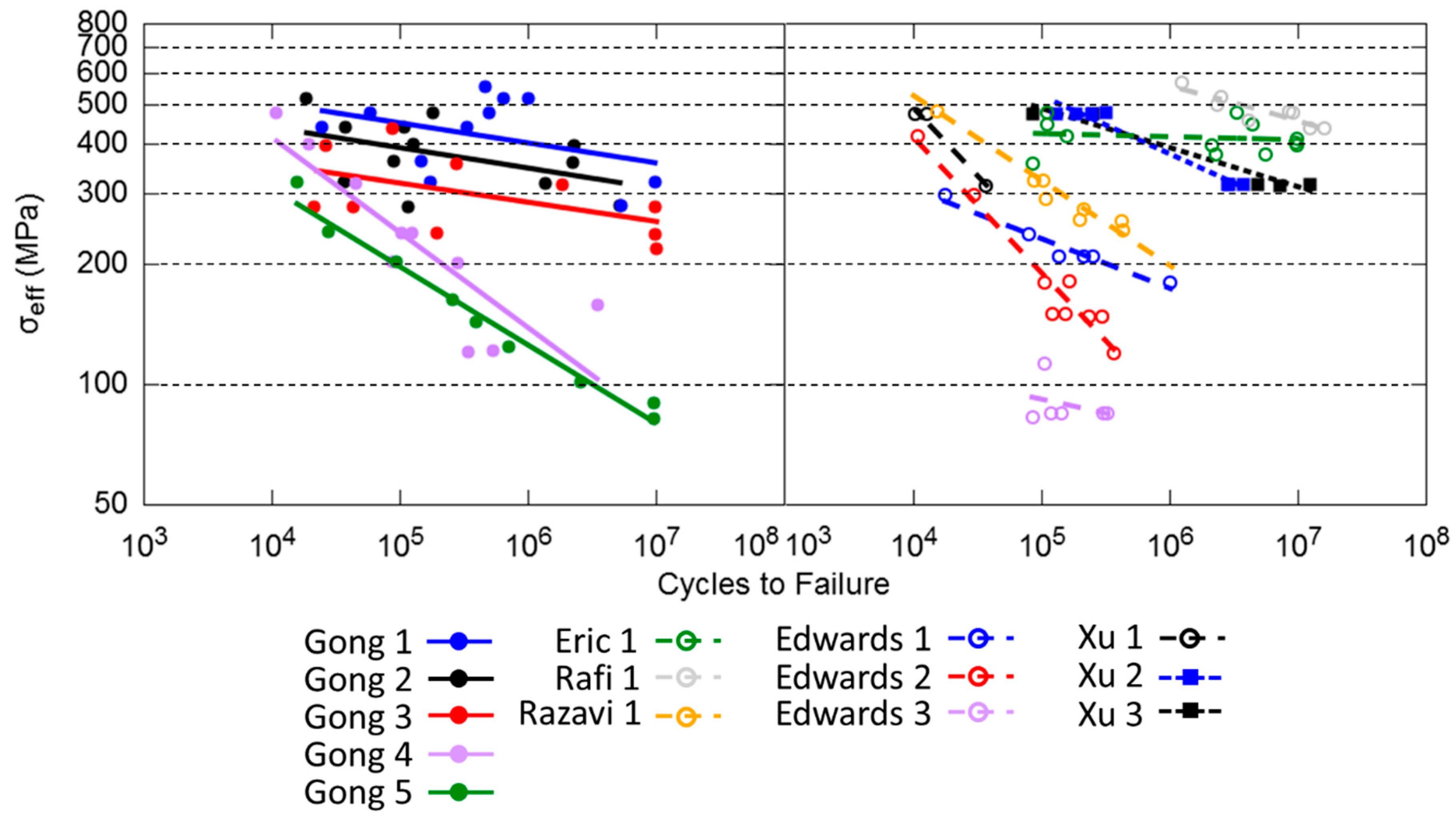
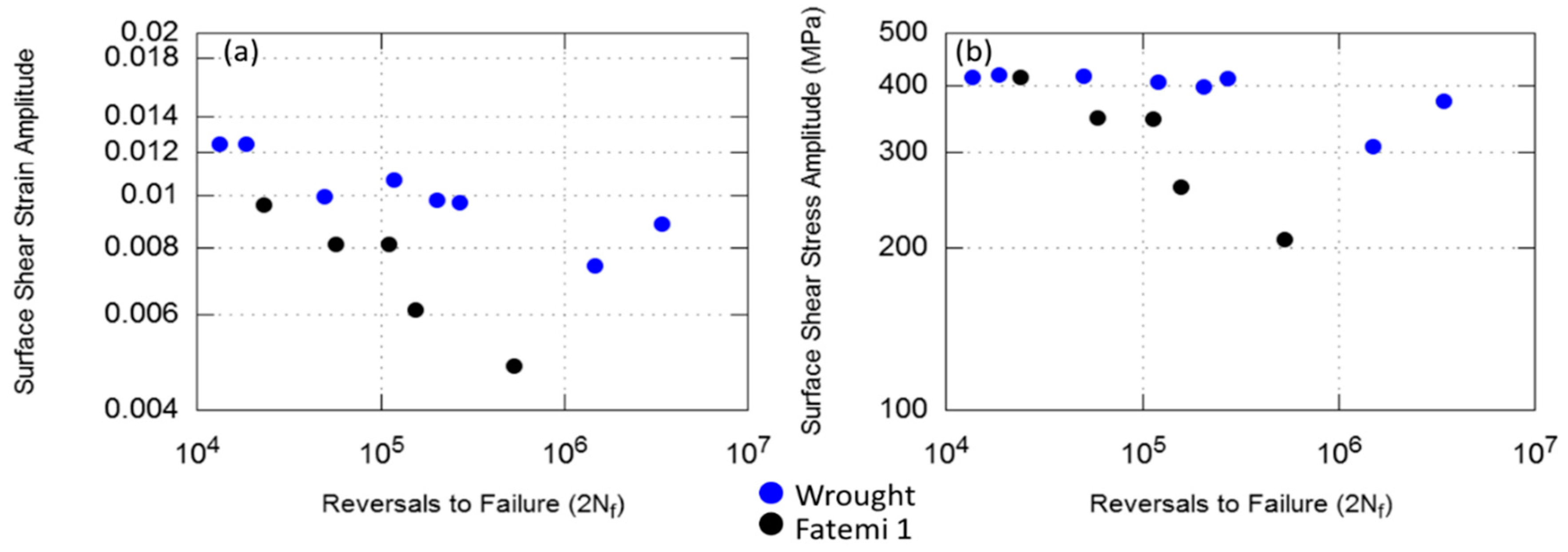

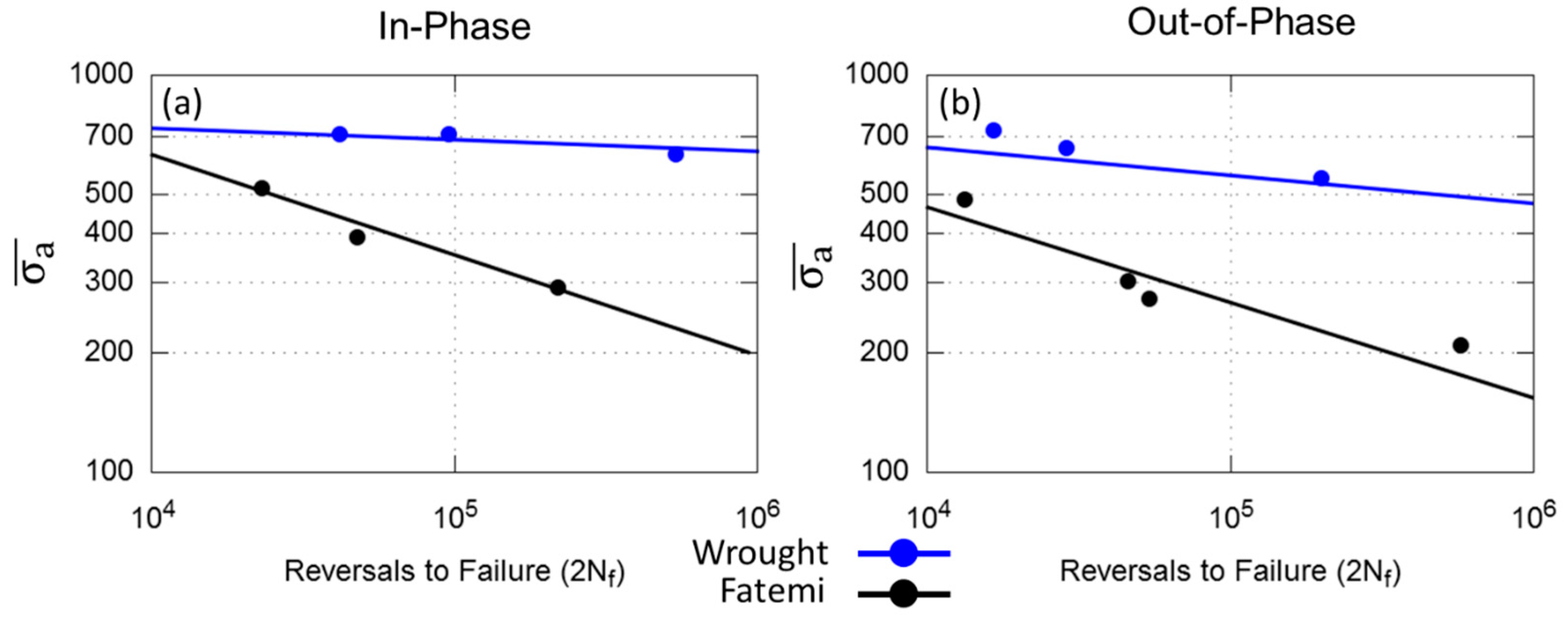
| Label | Reference | Build Orientation | Microstructure | Porosity (vol %) (Compared to Standard Density of Ti-6Al-4V 4.43 ) | Post Treatment |
|---|---|---|---|---|---|
| Cain | [40] | Flat XY, ZX | martensite | <1 | None |
| Kasperovich | [26] | Cylindrical Z | martensite | 0.077 | None |
| Leuders | [43] | Cylindrical Z | martensite | NR | None |
| Simonelli | [8] | Flat XY, ZX, XZ | martensite | NR | None |
| Facchini | [41] | Flat Z | martensite | 0.3 | None |
| Gong 1 | [42] | Cylindrical Z | martensite | 0.45 | None |
| Gong 2 | 1.37 | ||||
| Gong 3 | 5.23 | ||||
| Gong 4 | 1.37 | ||||
| Gong 5 | 5.48 | ||||
| Vilaro | [20] | Flat (X or Y), Z | martensite | <1 | None |
| Mertens | [44] | Flat XZY | martensite | <0.5 | None |
| Hollander | [46] | Cylindrical (X or Y) | NR | <0.5 | None |
| Qui | [6] | Cylindrical Z, (X or Y) | martensite | <0.1 | None |
| Xu 1 | [9] | Cylindrical Z | Coarse lamellar ( + ) | NR | None |
| Xu 2 | [15] | Cylindrical Z | Ultrafine lamellar ( + ) | <0.5 | None |
| Label | Reference | Laser Power (W) | Scan Speed (mm/s) | Hatch Spacing (m) | Layer Thickness (m) | Baseplate Temperature (°C) | Scanning Strategy | Multiple or Single Build |
|---|---|---|---|---|---|---|---|---|
| Cain 1 | [40] | NR | NR | NR | NR | NR | 1 | Single |
| Kasperovich | [26] | 200 | 1250 | NR | 40 | NR | NR | Multiple |
| Leuders | [43] | 400 | NR | NR | 30 | NR | NR | NR |
| Simonelli | [8] | 157 | 225 | 100 | 50 | NR | 2 | Multiple |
| Facchini | [41] | 195 | 225 | NR | NR | NR | NR | Multiple |
| Gong 1 | [42] | 120 | 960 | 100 | 30 | NR | NR | Multiple |
| Gong 2 | 540 | |||||||
| Gong 3 | 400 | |||||||
| Gong 4 | 1260 | |||||||
| Gong 5 | 1500 | |||||||
| Vilaro | [20] | 160 | 600 | 200 | 40 | 500 | Strategy 4 in a 5 × 5 region | NR |
| Mertens | [44] | 175 | 710 | 120 | 30 | NR | Strategy 5 in chessboard pattern | NR |
| Hollander | [46] | NR | NR | NR | NR | NR | NR | NR |
| Qui | [6] | 150–200 | 800–1500 | 75 | 20 | NR | Chessboard | Multiple |
| Xu 1 | [9] | 375 | 686–1029 | 120 | 60 | 200 | Chessboard | Multiple |
| Xu 2 | [15] | 175–375 | 686–1029 | 120 | 30-90 | 200 | NR | Multiple |
| Coupon | Shear Modulus (GPa) | Shear Yield Strength (MPa) | Shear Ultimate Strength (MPa) | Shear Fracture Strain (%) |
|---|---|---|---|---|
| Wrought | 42 | 523 | - | - |
| SLM | 42.5 | 634 | 699 | 4.56 |
| Reference | Build Orientation | Microstructure | Porosity (vol %) (Compared to Standard Density of Ti-6Al-4V 4.43 ) | Post Treatment |
|---|---|---|---|---|
| [47] | Tubular coupon, z | NR | NR | Annealed at 700 °C for 1 h |
| Reference | Laser Power (W) | Scan Speed (mm/s) | Hatch Spacing (m) | Layer Thickness (m) | Baseplate Temperature (°C) | Scanning Strategy | Multiple or Single Build |
|---|---|---|---|---|---|---|---|
| [47] | 400 | 1000 | 160 | 50 | NR | 2 | NR |
| Label | Reference | Build Orientation | Microstructure | Porosity (vol %) (Compared to Standard Density of Ti-6Al-4V 4.43 ) | Post Treatment |
|---|---|---|---|---|---|
| Van Hooreweder | [52] | XY | martensite | 0.27 | None |
| Leuders 1 | [32] | ZX | martensite | 0.23 | None |
| Leuders 2 | XZ | ||||
| Cain 1 | [40] | XZ | martensite | <1 | None |
| Cain 2 | ZX | ||||
| Cain 3 | XY | ||||
| Edwards 1 | [53] | XY | martensite | NR | None |
| Edwards 2 | YZ | ||||
| Edwards 3 | XZ |
| Label | Reference | Laser Power (W) | Scan Speed (mm/s) | Hatch Spacing (m) | Layer Thickness (m) | Baseplate Temperature (°C) | Scanning Strategy | Multiple or Single Build |
|---|---|---|---|---|---|---|---|---|
| Van Hooreweder | [52] | 250 | 1060 | 60 | 30 | NR | 1 | NR |
| Leuders 1/Leuders 2 | [32] | 400 | NR | NR | 30 | 100 | NR | NR |
| Cain 1 | [40] | NR | NR | NR | NR | NR | 1 | Single |
| Cain 2 | Single | |||||||
| Cain 3 | Multiple | |||||||
| Edwards 1/Edwards 2/Edwards 3 | [53] | 200 | 200 | 180 | 50 | NR | 2 | Multiple |
| Label | Reference | Build Orientation | Microstructure | Porosity (vol %) (Compared to Standard Density of Ti-6Al-4V 4.43 ) | Post Treatment |
|---|---|---|---|---|---|
| Eric 1 | [60] | Cylindrical coupon at 45° to build plate | martensite | 0.40 | Heat treatment—650 °C for 3 h |
| Gong 1 | [42] | Cylindrical coupon Z | martensite | 0.45 | None |
| Gong 2 | 1.37 | ||||
| Gong 3 | 5.23 | ||||
| Gong 4 | 1.37 | ||||
| Gong 5 | 5.48 | ||||
| Xu 1 | [16] | Cylindrical coupon, Z | martensite | NR | None |
| Xu 2 | Cylindrical coupon, Z | Lamellar () | |||
| Xu 3 | Cylindrical coupon, horizontal | ||||
| Rafi 1 | [61] | Vertical | martensite | NR | Heat treatment—650 °C for 4 h |
| Edwards 1 | [62] | Flat coupon, X | martensite | NR | None |
| Edwards 2 | Flat coupon, Y | ||||
| Edwards 3 | Flat coupon, Z | ||||
| Razavi 1 | [63] | Cylindrical coupon, Z | martensite | 0.30 | Heat treatment—650 °C for 3 h |
| Label | Parameter | Laser Power (W) | Scan Speed (mm/s) | Hatch Spacing (m) | Layer Thickness (m) | Baseplate Temperature (°C) | Scanning Strategy | Multiple or Single Build |
|---|---|---|---|---|---|---|---|---|
| Eric 1 | [60] | 179 | 1250 | 100 | 30 | NR | NR | NR |
| Gong 1 | [42] | 120 | 960 | 100 | 30 | NR | NR | Multiple |
| Gong 2 | 540 | |||||||
| Gong 3 | 400 | |||||||
| Gong 4 | 1260 | |||||||
| Gong 5 | 1500 | |||||||
| Xu 1 | [16] | 375 | 1079 | 180 | 60 | 200 | NR | NR |
| Xu 2 | 120 | |||||||
| Xu 3 | ||||||||
| Rafi 1 | [61] | 170 | 1250 | 100 | 30 | NR | 3 | NR |
| Edwards 1/Edward 2/Edward 3 | [62] | 200 | 200 | 180 | 50 | NR | 2 | Multiple |
| Razavi 1 | [63] | NR | NR | NR | 60 | NR | NR | NR |
| Reference | Build Orientation | Microstructure | Porosity (vol %) (Compared to Standard Density of Ti-6Al-4V 4.43 ) | Post Treatment |
|---|---|---|---|---|
| [47] | Tubular coupon, Z | NR | NR | Annealed at 700 °C for 1 h |
| Reference | Laser Power (W) | Scan Speed (mm/s) | Hatch Spacing (m) | Layer Thickness (m) | Baseplate Temperature (°C) | Scanning Strategy | Multiple or Single Build |
|---|---|---|---|---|---|---|---|
| [47] | 400 | 1000 | 160 | 50 | NR | 2 | NR |
| Reference | Build Orientation | Microstructure | Porosity (vol %) (Compared to Standard Density of Ti-6Al-4V 4.43 ) | Post Treatment |
|---|---|---|---|---|
| [71,72,73] | Cylindrical Z | martensite | NR | None |
| Reference | Laser Power (W) | Scan Speed (mm/s) | Hatch Spacing (m) | Layer Thickness (m) | Baseplate Temperature (°C) | Scanning Strategy | Multiple or Single Build |
|---|---|---|---|---|---|---|---|
| [71] | 175 | 710 | 120 | 30 | 200 | NR | Multiple |
| [72] | 175 | 710 | 120 | 30 | 200 | NR | Multiple |
| [73] | 100 | 375 | 130 | 30 | 200 | Stripe pattern | Multiple |
| Label | Reference | Build Orientation | Microstructure | Porosity (vol %) (Compared to Standard Density of Ti-6Al-4V 4.43 ) | Post Treatment |
|---|---|---|---|---|---|
| Fatemi 1 | [48] | Tubular coupon, Z | NR | NR | None |
| Fatemi 2 | |||||
| Fatemi 3 | [77] | martensite | 0.1–0.6 | Heat treatment—700 °C for 1 h |
| Label | Reference | Laser Power (W) | Scan Speed (mm/s) | Hatch Spacing (m) | Layer Thickness (m) | Baseplate Temperature (°C) | Scanning Strategy | Multiple or Single Build |
|---|---|---|---|---|---|---|---|---|
| Fatemi 1 | [47] | 400 | 1000 | 160 | 50 | NR | 2 | NR |
| Fatemi 2 | ||||||||
| Fatemi 3 | [76] | 400 | 1000 | 160 | 50 | NR | 2 | NR |
| Label | Reference | Build Orientation | Microstructure | Porosity (vol %) (Compared to Standard Density of Ti-6Al-4V 4.43 ) | Post Treatment |
|---|---|---|---|---|---|
| Fatemi | [76] | Tubular coupon, Z | martensite | 0.1-0.6 | Heat treatment—700 °C for 1 h |
| Label | Reference | Laser Power (W) | Scan Speed (mm/s) | Hatch Spacing (m) | Layer Thickness (m) | Baseplate Temperature (°C) | Scanning Strategy | Multiple or Single Build |
|---|---|---|---|---|---|---|---|---|
| Fatemi | [76] | 400 | 1000 | 160 | 50 | NR | 2 | NR |
© 2018 by the authors. Licensee MDPI, Basel, Switzerland. This article is an open access article distributed under the terms and conditions of the Creative Commons Attribution (CC BY) license (http://creativecommons.org/licenses/by/4.0/).
Share and Cite
Agius, D.; Kourousis, K.I.; Wallbrink, C. A Review of the As-Built SLM Ti-6Al-4V Mechanical Properties towards Achieving Fatigue Resistant Designs. Metals 2018, 8, 75. https://doi.org/10.3390/met8010075
Agius D, Kourousis KI, Wallbrink C. A Review of the As-Built SLM Ti-6Al-4V Mechanical Properties towards Achieving Fatigue Resistant Designs. Metals. 2018; 8(1):75. https://doi.org/10.3390/met8010075
Chicago/Turabian StyleAgius, Dylan, Kyriakos I. Kourousis, and Chris Wallbrink. 2018. "A Review of the As-Built SLM Ti-6Al-4V Mechanical Properties towards Achieving Fatigue Resistant Designs" Metals 8, no. 1: 75. https://doi.org/10.3390/met8010075





